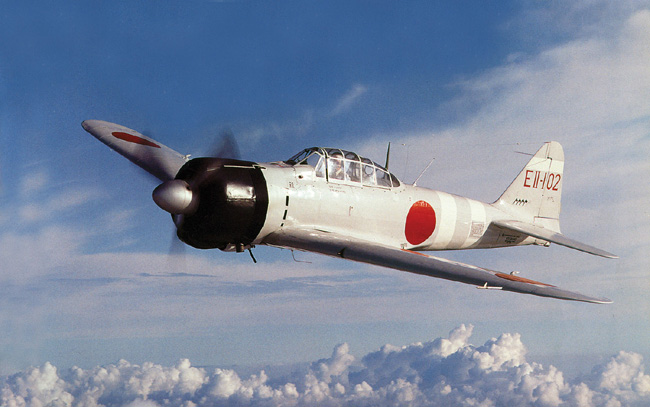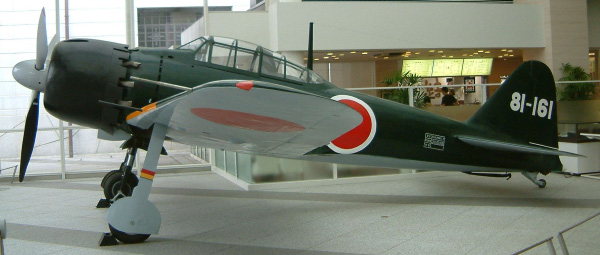
|
Mitsubishi A6M Reisen (Zero-Sen) |
 |
||||||||
|---|---|---|---|---|---|---|---|---|---|---|
 |
 |
 |
 |
 |
 |
 |
 |
 |
 |
 The Mitsubishi A6M Zero was the most produced Japanese aircraft of World War II. |
|
The Mitsubishi A6M Zero-Sen legendary status mirrored the fortunes of the rising sun in which four years, the sun would finally set. For the Japanese and its former enemies, the A6M was the symbol of Japanese air power and marked the beginning of a new epoch in naval aviation. With its tight turning radius, it was an extremely deadly weapon in a dogfight, and was famous for its ability to outmaneuver, the Brewster F2A Buffalo, the Curtiss P-40 and the Grumman F4F Wildcat. It was the first shipboard fighter capable of surpassing land-based aircraft.1 As early as 1937, Claire Chennault, the author of 'The Role of Defensive Pursuit,' warned the USAAF about the dangers of Japanese air power. Apparently his warnings were ignored as the superiority of the A6M was a complete surprise to the American forces.2 As leader of the Flying Tigers, Chennault constantly stressed to his pilots, "Never try to turn with a Zero. Always get above the enemy and try to hit him with the first pass."3 Because of the A6Ms exceptional range and performance, it was to bear the brunt of the action of almost every military engagement in the Pacific until the end of the war. 4 On May 19, 1937, the Japanese Imperial Navy submitted specifications for a new navy fighter to supersede the Mitsubishi A5M, Navy Type 96 Carrier Fighter which had just become operational. The requirements called for were:
• Maximum speed of 270 kt @ 4,000 m.

The Navy ordered two prototypes and plans were submitted by Nakajima and Mitsubishi. Nakajima elected to drop their proposal for a fighter design and Mitsubishi submitted their design led by designer Jiro Horikoshi. The Mitsubishi A6M1 prototype was an all metal, low-wing monoplane with retractable gear, and powered by a 780 hp (580 kW) Mitsubishi Zuisei 13 engine. During flight testing, the two-blade variable-pitch propeller was replaced with a three-blade variable pitch propeller. Apart from maximum speed, all requirements were met or exceeded.5 The Navy had authorized the production of an initial batch of A6M2s and military trials progressed rapidly. While flight testing the A6M1, a new power plant passed its Navy acceptance tests, and the 925 hp (690 kW) Nakajima NK1C Sakae 12, which was slightly larger than the Zuisei, was installed in the third A6M2 prototype. The initial trials were completed in July 1940 and the navy assigned fifteen A6M2s to combat trials in China. In China, the A6M2s reinforced with a number of production aircraft, destroyed 99 Chinese aircraft with a loss of only two of their own. The aircraft was accepted for production on July 1940 as Navy Type 0 Carrier Fighter Model 11, and in September 1941 were prepared for the impending war with the Allies. Modifications were introduced during production and the A6M2 rear spar was reinforced and manually folding wingtips were incorporated to allow clearance on the carrier's deck elevators. The modified aircraft was designated Navy Type 0 Carrier Fighter Model 21. The A6M2 Model 21 was the version utilized at Pearl Harbor and throughout the Pacific during the early stages of the war. Six months before the attack on Pearl Harbor a new version of the Reisen, the A63M was fitted with a 1,130 hp Nakajima Sakae 21 fourteen-cylinder radial engine with a two-speed supercharger instead of a one-speed unit used on the Sakae 12. The new engine required moving of the engine firewall further aft by 18 inches and reducing the fuselage fuel tank capacity from 98 liters to 60 liters. The Sakae 21 had a higher fuel consumption than the Sakae 12, and 45-liter fuel tanks were installed in each wing outboard of the cannon bay. The installation of the wing fuel tanks restored the range of the Zero to its original level. Other modifications included increasing the 20 mm cannon capacity from 60 rpg to 100 rpg and the folding wingtips were removed which resulted in an increase in level speed. The squared off wing tips caused some confusion with the Allies who mistakenly thought it was completely new fighter and it was designated as the HAMP. After it was discovered, it was the same airplane, the HAMP designation was dropped. The A6M3 was designated Navy Type 0 Carrier Fighter Model 32. Three hundred and forty-three of this variant were built by Mitsubishi and an unspecified amount were built by Nakajima. With its maximum speed of 331 mph (532 km/h) and the ability to climb to 6,000 m in 7 minutes 27 seconds, it possessed an ascendancy over any other fighter type in the Pacific. When the war began, the Japanese Navy had 328 A6M2s in first line units. On December 7, 1941, the Japanese Imperial Navy launched 353 aircraft from six carriers in a surprise attack, against US military installations at Pearl Harbor, on the island of Oahu, Hawaii. The aircraft included in the raid were A6M2s, Nakajima B5Ns and Aichi D3As.

The A6M possessed many shortcomings, which were only to be revealed six months later when a virtually intact specimen was obtained. On 3 June 1942, Flight Petty Officer Tadayoshi Koga left the flight deck of the carrier Ryujo in his Mitsubishi A6M2 Model 21 fighter as part of a task force assigned to attack Dutch Harbor in the Aleutian Islands. His A6M2, which had been built in February, was on its first operational mission. On his way back to the Ryujo, Koga found that two bullets had punctured his fuel supply and he informed his flight commander that he intended to land on Akutan Island, designated as an emergency landing field. Koga did not make the landing field and instead made a forced landing in a marsh where the aircraft flipped over, in which he broke his neck and was killed. Five weeks later, a US Navy PBY Catalina, making a routine patrol, discovered the Japanese fighter upside down in the marsh. This single fighter was probably one of the greatest prizes of the Pacific war. Hardly damaged, it was shipped back to the USA where it was exhaustively tested. The Zero also lacked armor protection for the pilot and self-sealing-fuel tanks and was overrated in some areas, including its fabled maneuverability.6 Modified Zeros, assigned to Air Group 201 in the Philippines, were the first Japanese aircraft used on planned suicide missions against American surface vessels. Air Group 201, assisted by volunteer pilots from Air Group 601 and other Navy units in the area, became the first Kamikaze (Divine Wind) suicide squadron in the Japanese Naval Air Force. The outstanding successes gained by this form of attack led to the formation of other Kamikaze units, and the bomb-carrying Zeros became the prime suicide attack bombers of the Navy.

More Zero-Sens were produced than any other wartime Japanese aircraft. Mitsubishi alone produced 3,879 aircraft of this type, and Nakajima built 6,215. Altogether, with the 844 trainer and floatplane variants produced by Sasebo, Hitachi and Nakajima, production of the A6M series aircraft totaled 10,938 aircraft. The Zero-Sen possessed complete mastery in the air over the Pacific until the Battle of Midway in June 1942, which became the actual turning point of the Pacific War, although very few knew it at the time. The value of the Zero steadily declined and its lowest point was reached when it was selected to lead the Navy's Air Force in mass suicide attacks. The installation of the Kinsei engine brought Zero-Sen closer to Allied standards attained at that stage in the war, but the overwhelming industrial capacity of the United States made it apparent that victory for the Allies had become a foregone conclusion. The airplane that started the Pacific war was no longer able to fight it—nor was the nation that conceived it. |
| Specifications: | ||
|---|---|---|
| A6M2 - Model 21 | A6M5 - Model 52 | |
| Dimensions: | ||
| Wing span: | 39 ft 4 7/16 in (12 m) | 46 ft 1 1/16 in (11 m) |
| Length: | 29 ft 8 11/16 in (9.06 m) | 29 ft 11 3/32 in (9.121 m) |
| Height: | 10 ft 0 1/16 in (3.05 m) | 11 ft 6 5/32 in (3.509 m) |
| Weights: | ||
| Empty: | 3,704 lb. (1,680 kg) | 4,136 lb. (1,876 kg) |
| Loaded: | 5,313 lb (2,410 kg) | 6,025 lb (2,733 kg) |
| Performance: | ||
| Maximum Speed: |
331.5 mph (288 kt) @ 14,930 ft (4,550 m) |
351 mph (305 kt) @ 19,685 ft (6,000 m) |
| Service Ceiling: | 32,810 ft. (10,000 m) | 38,520 ft. (11,740 m) |
| Maximum Range: | 1,930 miles (3,107 km) | 1,194 miles (1,922 km) |
| Powerplant A6M2: | Powerplant A6M5: |
|---|---|
| One Nakajima NK1C Sakae 12, fourteen cyl., air-cooled, radial engine rated at 940 hp for takeoff and 950 hp @ 13,780 ft (4,200 m), driving a three-blade metal propeller. | One Nakajima NK1F Sakae 21, fourteen cyl., air-cooled, radial engine rated at 1,130 hp for takeoff and 980 hp @ 19,685 ft (6,000 m), driving a three-blade metal propeller. |
| Armament: | |
|
Two forward-firing 7.7 mm Type 97 machine-guns in the upper fuselage and two wing-mounted 20 mm Type 99 cannon with two external 132 lb (60 kg) bombs. | |
| Endnotes: | |
|---|---|
|
1. Heiner Emde and Carlo Demand. Conquerors of the Air. New York: Viking Press, 1969. 2. David Mondey. The Concise Guide to Axis Aircraft of World War II. New York: Smithmark Publishers, 1996. 194. 3. Robert D. Loomis. Great American Fighter Pilots of World War II. New York: Random House, 1961. 47-48. 4. Rene J. Francillon, Japanese Aircraft of the Pacific War, Mitsubishi A6M Reisen (Zero Fighter). Annapolis, Maryland: Naval Institute Press, 1995. 362. 5. Ibid. 363-364. 6. Robert F. Dorr, Why the P-38 Flunked in Europe. Aviation History. May 2014. 29. | |
Return To Aircraft Index.
©Larry Dwyer. The Aviation History Online Museum.
All rights reserved.
Created October 11, 1996. Updated February 12, 2023.